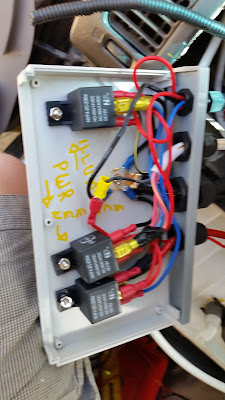Hello and welcome to post #20 on my project of building a custom in-car pc and now also an infotainment and gaming(!) platform.
Today we decided to install a USB wireless dongle to add extra wireless networking capabilities to the car. One such use for these is creating an "ad-hoc" network where the car PC becomes the equivalent of a wifi hotspot/mobile LAN router. This opens up more possibilities and options for networking the PC and integrating it with mobile devices such as smartphones.
 |
| The USB Adapter in question |
I fitted a TP-Link TL-WN727N USB 2.0 150MB/S wireless adapter. Its the lowest model TP link makes but I had it as a spare so i figured it couldn't hurt to try it.
After connecting it to the car (it uses standard windows drivers which installed automatically) to the computer we downloaded Wireless Adhoc Manager, which is an application which easily allows the user to create an ad-hoc network. It allows the user to set the SSID (the name of the wifi network) and password quickly and easily with no fuss.
One immediate use to improve the PC's usability is to connect my phone to the new wifi network and open Splashtop Remote HD to remote control the PC in real-time HD. When I buy a wireless or satellite transceiver for mobile internet anywhere this will allow setting up the car as a mobile hotspot.
One added advantage of having an additional wifi adapter (The PC now has 2) is that it allows devices to be connected to the TP-link while retaining its internet connection over my home wifi network.
For the windows 10 UI improvements, we did the following:
For the windows 10 UI improvements, we did the following:
- Change windows explorer default start-up page to "this PC" from "Quick access"
- Removed the search button from the task bar to free up more space
- Removed cortana from the start menu and rearranged icons
Finally, we installed Spintireshttp://spintires.com/.
 |
| Spintires opening video |
Spintires is a challanging co-operative multilayer offroad driving simulator game set in 1980's soviet russia. The player can choose from over 18 different Russian trucks ranging from light 4X4 scout vehicles to lumbering 8X8 trucks. The objective to the game is to drive from a garage to logging stations, pick up lumber and deliver it to an objective whilst driving through extreme terrain such as mud, swamps, lakes, water crossings, beaches, forests and rocky hills. The trucks can be customized with various attachments such as fuel tanks, repair kits (trucks incur damage if you drive them too rough).
Spintires is only available on PC through steam (I installed it prior to the game)
 |
| In-game screenshot a truck slogging its way through mud |
 |
| A truck edging its way across a rickety bridge. The level of detail in the game is impressive; the bridge flexes and creaks, threatening to collapse as the truck rolls over it. |
Unsurprisingly the PC with its 4th generation Intel core i3 processor clocked at 3.8ghz and no graphics card (It has onboard intel HD4000 series graphics built into the CPU) the computer struggled hard to run the game at full settings, stuttering at roughly 10FPS. After some tweaking of the settings (720P resolution, Shaders set to low, Draw distance set to medium, Grass density low, Level of detail medium, Mud detailization on and most of the check boxes turned off
 |
| Spintires graphics settings menu. Note this is not my screenshot, I don't know how they managed to run a 6000X1080 resolution. |
I can now proudly call my computer system a fully fledged multimedia and gaming platform, along with its other titles. As an added bonus I'll never get bored if I'm stuck waiting in my car again :). Goodbye and thanks for reading.
TLDR: I can no go 4wding from within my 4wd. I call it fourbyception :D
TLDR: I can no go 4wding from within my 4wd. I call it fourbyception :D







































